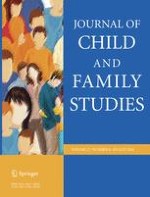09-05-2018 | Original Paper
African American and Latina Adolescent Mothers’ and their Children’s Fathers’ Reports of Coparenting and Child Behavior Problems: Child Gender as a Moderator
Gepubliceerd in: Journal of Child and Family Studies | Uitgave 8/2018
Log in om toegang te krijgenAbstract
Coparenting, the way that parents work together in their roles to parent children, has emerged as an important area for prevention and intervention. Though research indicates that low coparenting quality is associated with increased externalizing and internalizing behavior problems in children, the existing literature is not inclusive of families diverse in sociocultural identity and structure. We examined the link between coparenting and externalizing and internalizing behavior problems and tested the moderating effect of child gender on the relationship between coparenting and child behavior problems in two-year-old children of African American and Latina adolescent mothers. One hundred and thirty five parents (69 mothers and 66 fathers) completed self-report measures of coparenting and child behavior problems when their children were two years old. While we did not find support for a direct association between coparenting quality and child behavior problems, child gender did moderate the association between mother’s report of coparenting quality and both externalizing and internalizing behavior problems. High coparenting quality was associated with lower levels of externalizing behavior problems in girls and higher levels of externalizing behavior problems in boys. High quality coparenting was associated with lower levels of internalizing behavior problems in girls, but there was no difference for boys. Though the results for boys were mixed, our findings for girls suggest that high quality coparenting may be a protective factor for the development of both internalizing and externalizing behavior problems. Implications for future research are discussed.
